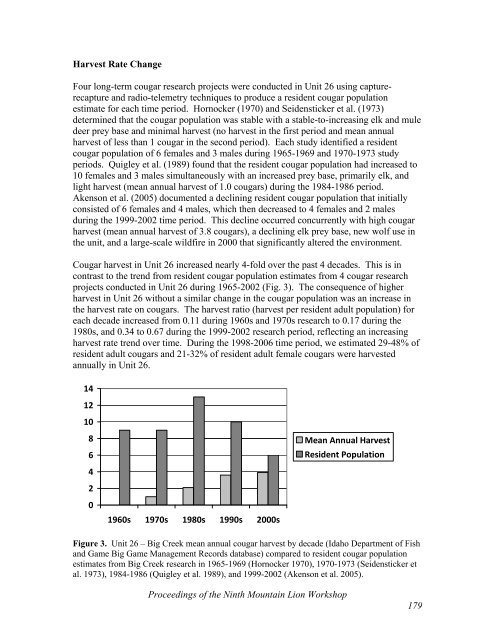Proceedings of the Ninth Mountain Lion Workshop - Carnivore ...
Proceedings of the Ninth Mountain Lion Workshop - Carnivore ...
Proceedings of the Ninth Mountain Lion Workshop - Carnivore ...
You also want an ePaper? Increase the reach of your titles
YUMPU automatically turns print PDFs into web optimized ePapers that Google loves.
Harvest Rate Change<br />
Four long-term cougar research projects were conducted in Unit 26 using capturerecapture<br />
and radio-telemetry techniques to produce a resident cougar population<br />
estimate for each time period. Hornocker (1970) and Seidensticker et al. (1973)<br />
determined that <strong>the</strong> cougar population was stable with a stable-to-increasing elk and mule<br />
deer prey base and minimal harvest (no harvest in <strong>the</strong> first period and mean annual<br />
harvest <strong>of</strong> less than 1 cougar in <strong>the</strong> second period). Each study identified a resident<br />
cougar population <strong>of</strong> 6 females and 3 males during 1965-1969 and 1970-1973 study<br />
periods. Quigley et al. (1989) found that <strong>the</strong> resident cougar population had increased to<br />
10 females and 3 males simultaneously with an increased prey base, primarily elk, and<br />
light harvest (mean annual harvest <strong>of</strong> 1.0 cougars) during <strong>the</strong> 1984-1986 period.<br />
Akenson et al. (2005) documented a declining resident cougar population that initially<br />
consisted <strong>of</strong> 6 females and 4 males, which <strong>the</strong>n decreased to 4 females and 2 males<br />
during <strong>the</strong> 1999-2002 time period. This decline occurred concurrently with high cougar<br />
harvest (mean annual harvest <strong>of</strong> 3.8 cougars), a declining elk prey base, new wolf use in<br />
<strong>the</strong> unit, and a large-scale wildfire in 2000 that significantly altered <strong>the</strong> environment.<br />
Cougar harvest in Unit 26 increased nearly 4-fold over <strong>the</strong> past 4 decades. This is in<br />
contrast to <strong>the</strong> trend from resident cougar population estimates from 4 cougar research<br />
projects conducted in Unit 26 during 1965-2002 (Fig. 3). The consequence <strong>of</strong> higher<br />
harvest in Unit 26 without a similar change in <strong>the</strong> cougar population was an increase in<br />
<strong>the</strong> harvest rate on cougars. The harvest ratio (harvest per resident adult population) for<br />
each decade increased from 0.11 during 1960s and 1970s research to 0.17 during <strong>the</strong><br />
1980s, and 0.34 to 0.67 during <strong>the</strong> 1999-2002 research period, reflecting an increasing<br />
harvest rate trend over time. During <strong>the</strong> 1998-2006 time period, we estimated 29-48% <strong>of</strong><br />
resident adult cougars and 21-32% <strong>of</strong> resident adult female cougars were harvested<br />
annually in Unit 26.<br />
14<br />
12<br />
10<br />
8<br />
6<br />
4<br />
2<br />
0<br />
1960s 1970s 1980s 1990s 2000s<br />
Mean Annual Harvest<br />
Resident Population<br />
Figure 3. Unit 26 – Big Creek mean annual cougar harvest by decade (Idaho Department <strong>of</strong> Fish<br />
and Game Big Game Management Records database) compared to resident cougar population<br />
estimates from Big Creek research in 1965-1969 (Hornocker 1970), 1970-1973 (Seidensticker et<br />
al. 1973), 1984-1986 (Quigley et al. 1989), and 1999-2002 (Akenson et al. 2005).<br />
<strong>Proceedings</strong> <strong>of</strong> <strong>the</strong> <strong>Ninth</strong> <strong>Mountain</strong> <strong>Lion</strong> <strong>Workshop</strong><br />
179
















